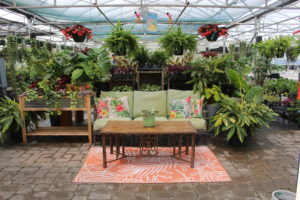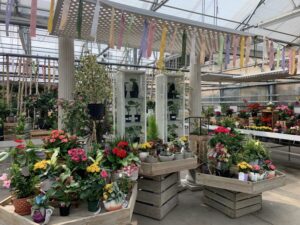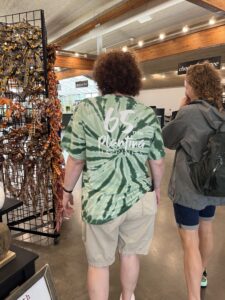Lawn & Garden Retailer Headlines
From OFA to YOU
Plan Now to Attend The OFA Short Course
By Kathy Benken, OFA President
Mark your calendar now OFA Short Course registration and hotel reservations will open April 25. This is a terrific opportunity to join your peers at U.S. floriculture’s premier educational and trade show event. OFA provides quality education for all areas of floriculture, and the Short Course, which will be held July 9-12 in Columbus, Ohio, is our most well-known activity each year.
If you are a member of OFA or attended Short Course last year, you will receive the 2005 program in the mail this month. The program is also available on OFA’s Web site: www.ofa.org. The registration and hotel reservation forms are included in the program, along with descriptions of the 120 plus educational sessions, the current exhibitor list, the trade show map and highlights of other events during the week.
What can you do in Columbus in July, you ask? Network with industry leaders; compare notes with your peers; keep an eye on your competitors; improve your technical knowledge; hone your business skills; and renew old acquaintances and make new friends just for starters.
Harold Lloyd will present this year’s keynote address Am I the Leader I Need to Be? on Saturday, July 9 at 5:45 p.m. Join us for an OFA awards presentation and Harold’s discussion about 10 critical leadership qualities.
OFA prides itself on hosting a diverse audience, a broad range of companies and many industry leaders all under one roof. The best of the best, from all over the United States and more than 25 countries, attend Short Course each year. Consider this your invitation to be part of OFA’s “in crowd” those who know where to find the best information and the best people in floriculture. This summer, join us at the Short Course and get your own worldwide perspective on what’s happening in floriculture!
Management Clinic A Big Draw
Nearly 1,000 attendees embarked on a Jungle Adventure with safari tour guides at this year’s American Nursery & Landscape Association Management Clinic, February 2-5, Louisville, Ky. The tone was set to the analogy that the jungle is the business/retail world and vice versa. Thursday through Saturday, the mornings were dedicated to congregating as a large group before the day’s activities began.
Tom McDonald began Thursday morning with an interactive presentation: “Unlocking the Power of Business Creativity.” As in McDonald’s talk, networking is strongly encouraged by this Clinic. The Management Clinic prides itself on being one of the few opportunities where people in the industry can gather and strictly network and improve their business in every aspect. Because the Clinic is made up of workshops and guest speakers, the attendees are not distracted or overbooked.
Workshops were divided into nine categories: retail business basics, retail business management, design/build, landscape business management, grower business management, landscape distribution, human resources and finance, personal growth, and team building. Some sessions overlapped categories, but all were well integrated and applicable to the green industry.
Friday morning guest speaker Jonathan Pontell introduced Generation Jones, the generation lost between the Baby Boomers and Generation X. Pontell created/identified this idea in an effort to better describe and categorize those born between 1954 and 1965. Pontell discussed how Generation Jones has an effect on the retail business and profits, pointing to research by Simmons that states Generation Jones is the majority generation of gardening consumers, which suggests that retailers should pay closer attention to the needs of the Jonesers. This generation is described as always wanting more, never being satisfied. They want the higher-end products that bring individuality and define the values of achieving individual success and shaping their life to their wants, needs and goals.
Other sessions provided valuable experience on how to create and enhance the culture in your workplace; building customers by utilizing relationship marketing; green roof system technology and design; insurance issues; effective merchandising, signage and selling; and niche marketing of high-end plant material. The Technology Reception provided a networking experience in the mist of seeing the new technologies that will enhance all aspects of the retail, landscape and grower businesses. Compared to past years, extra sessions were dedicated to advancing technology, its uses and how to incorporate it into your business in a simple, but effective way. The 2006 Management Clinic is scheduled for February 1-4. For more information contact ANLA at (202) 789-2900.
-Mackenzie Gaffney
Armstrong Growers Joins Novalis
Becoming the fifth member in the Novalis growers consortium, grower/retailer Armstrong Growers, Glendora, Calif., will introduce Novalis plant material in its 36 retail outlets starting in spring 2005. Additionally, Armstrong will make Novalis offerings available to other independent garden center retailers in California, Arizona and Nevada. Expanding the Novalis retail presence in the West, Armstrong joins Carolina Nurseries, S.C.; The Conard-Pyle Co., Pa.; Imperial Nurseries, Conn.; and Willoway Nurseries, Ohio who all grow and distribute Novalis plants to independent retailers in the Eastern, Southern and Midwest regions of the country.
Novalis, founded in 2002, grows and sells premium plants exclusively to independent garden centers. The three Novalis programs, Plants that Work Sun/Shade Perennials, Twice as Nice Daylilies and The National Parks Rose Collection, are supported with marketing and merchandising designed to boost sales at the retail level. With growing facilities in the East, South and now the West, Novalis programs are regionally tailored to consumer tastes and needs, assuring timely delivery of retail-ready quality plants for the garden center.
Initially, Armstrong will grow and sell Plants that Work, Sun/Shade Perennials in 1-quart and 71?2-inch sizes, Twice as Nice Daylilies in 71?2-inch pots and The National Parks Rose Collection in 3-gal. pots. In addition, Armstrong will be a grower/distributor for two Novalis exclusives for 2005, Double Knock Out Rose and Big Daddy Hydrangea. Novalis plants first appeared in Armstrong Garden Centers in the beginning of January 2005.
The Flower Fields Alive and Kicking
A major direction change for the Flower Fields program of Yoder Bothers and the Ecke Ranch was announced recently in anticipation of the Pack Trials. Bill Rasbach, president of Yoder Bothers, and Paul Ecke III, CEO of the Ecke Ranch, have outlined how the Flower Fields program has refocused on supporting grower and retailer brands.
“The biggest change is we have stopped talking about us and our ability to have our program influence consumer purchase; the reality is the true brands are happening with growers and with retailers,” said Rasbach. “We feel the role of the Flower Fields is to support those programs; we are the brand behind the brand,” he added.
Ecke said, “We have always been supportive of using our trademark and tag support with other programs. We are now making this brand support the major part of our market push. I feel strongly that the retailer is the brand, that our Flower Fields will best serve retailers and growers by supporting the programs offered by innovative businesses. To us,” Ecke continued, “this is really a B-to-B or Business-to-Business strategy; consumers are influenced by the retailer first and foremost, so let us help the retailer and their support of growers.”
Changes to the Flower Fields program include a more active support of using Flower Fields products and trademarks on existing labeling programs in addition to using the program as a stand-alone presence. All tags and POP material may be ordered separately and may be customized with retailer or grower brands. Christine Kelleher, marketing manager for Yoder went into detail, “I like to think of the Flower Fields as an a la carte menu; you can order plant tags and support signage in a wide range of choices; use our images and logos or not; we will support whatever is best for the customer.”
Kelleher continued, “Plant packaging works if you wrap a plant in a logo pot, use a large informative tag and support it with POP, you sell plants faster and for more profit. Our Flower Fields program offers off-the-shelf support with our tags and signage, and now we are pushing to do more co-branding and better support other programs. I see this as a classic win-win,” she added.
On the topic of plant material, the Flower Fields continues to have a wide assortment of top-selling annuals and perennials. Between the collections of Ecke and Yoder there are more than 1,000 cultivars with genetics suitable for any region of the country. This April, the two companies will introduce an additional 100 items to support growers and retailers who are looking for an advantage in the marketplace.
GCA Reorganizes
Garden Centers of America (GCA) has announced plans to build on its reorganization plan started three years ago, according to an announcement made by Steve Echter, GCA president.
“We have successfully made the transition in organizing GCA into a focused organization ready to respond to the needs of today’s independent garden center owners and operators. At this point GCA will take its next step in building on the foundation we have been able to create.” Echter said.
“The timing of our next move is right as Clayton Hannon, veteran industry association executive, concludes his interim executive vice-president role with GCA. Hannon has done an excellent job in helping lead GCA through the challenging re-organizational period of the past three years, and we were fortunate to have his leadership. When we asked him to come out of retirement to be of assistance to the GCA board in 2002, it was with the understanding his service would be limited in time, so his decision to step aside at this time was expected,” Echter added.
Hannon, with 37 years of association management experience, retired at the end of 1999 as the executive director of the Oregon Association of Nurserymen (now called Oregon Association of Nurseries). When GCA separated from ANLA in February 2002, he agreed to assist the GCA board of directors in its re-organizational efforts.
According to Echter, the GCA board of directors is currently reviewing its administrative options, with a decision to be made shortly. In all likelihood the GCA office will be relocated from its present Portland, Ore., headquarters to a location that will meet the needs of the new GCA management.
“GCA’s membership has grown, and its programming of tours and educational efforts has proven successful over the past three years. With this foundation, I feel comfortable that we will take the next steps necessary to provide a progressive representative base for independent garden centers,” Echter concluded.
Florists Fleeing
From Third-Party Fees
Though most florists conduct business with companies such as FTD and Teleflora, these relationships seem to be more of a problem than a money maker, argues an article by Mike Schneider for the Associated Press (AP).
According to the article, florists are “fed up with escalating membership fees and commissions, and an increasing number of florists are rejecting or reducing their reliance on third-party wire services and other businesses that gather orders from customers via ads in the phone book or on the Internet.”
In recent years, there has been a significant drop in the number of retail florists in the country. The AP states that the number has fallen “from 23,700-plus in 2001 to 21,700-plus last year, and many in the $19 billion floriculture industry think there is a direct link to the proliferation of third-party order-gatherers.”
The floral wire service market first started approximately 95 years ago as a go-between to help florists in different cities identify and fill out-of-town orders. “In recent years, wire services have begun working with and encouraging third-party businesses, which advertise directly to consumers. Neither the wire services nor many of the third-party businesses are florists. Instead, they gather orders that are funneled to local florists in exchange for a cut of the order,” stated the AP.
The article stated that normally the third party service that takes an order from the wire service will get a 20-percent commission while the wire service itself will get about 7 percent, and the actual florist that puts the whole thing together and delivers it will get about 73 percent. “The florists also pay dues and fees to the wire services that can cost several hundred dollars more a month,” the article stated.
“Third-party order-takers also get a commission of up to 20 percent. In addition, many charge shipping or handling charges of $2-9 an order and receive rebates of between $4-6 from the wire services. That can leave well below 73 percent for the florists who make the arrangements,” said the AP. This leaves little room for florists to make a profit.
In response to this problem, a number of florists have developed an association called the Independent Florists’ Associa-tion, an alternative network to the wire services.
According to the AP, the association “bypasses the wire services and third-party order-takers. Participating members, who pay modest membership dues and service fees, can choose either an 80 percent-20 percent split between the filling and order-sending florists or allow the florist filling the order to keep all the money.
“While doing business with wire services carries a cost, the wire services spend millions of dollars on advertising, which translates into more business for florists,” said Jennifer Sparks, spokeswoman for the Society of American Florists.
NASA Monitors Invasives
Invasive species of plants and insects now have a new enemy NASA satellites. According to an article in Medical News Today, NASA has accepted an invitation to join the National Invasive Species Council (NISC). NASA will be assisting 12 other Federal agencies in combating invasive species across the country by providing information from satellites.
According to the article, NASA satellite data will be used by the other federal agencies to help locate various plants. “The satellites will use bands of color from the spectrum to see the Sun’s light reflected by different plants and the environments in which Á they are growing,” the article explained. “The satellites will lock in on the combination of bands of color to determine an invasive plant’s current locations and areas that may develop a future invasion. Scientists are working now with the satellite data to see different plants.”
NASA has agreed to make its satellite observations of Earth, computer modeling and engineering experience available to NISC to improve the ability to help control and destroy invasive species that are harming the U.S. environment. NASA’s track record of achievement in the realm of invasive species monitoring led to NISC’s invitation to join the Council.
Ball’s IGC
Marketing Programs
Ball Horticultural Company has announced two new marketing programs exclusively for independent garden centers (IGC) in North America. The campaigns are intended to drive sales by focusing on successful sell-through at retail.
Ride The Wave
This brand was first introduced in 1995, and 10 years later the Wave petunia brand is center stage with a new look exclusively for independent garden center retailers. Campaign materials reflect the versatility of the plants from urban balconies to country properties, from traditional beds to cascading hanging baskets. With specially designed pots, POP materials and consumer brochures, the IGC Wave program has a different look but still takes advantage of the built-in power of existing Wave marketing. The company plans to support the new program with media initiatives designed to create new sales for the Wave program.
Simply Beautiful
In addition, Ball is launching a new program for Simply Beautiful, a collection of plants bred to create easy garden success for the consumer. Simply Beautiful addresses the typical frustrations of today’s busy gardeners who are tired of buying plants that do not meet their expectations or require too much time to care for. Selections in this collection are more tolerant of varying weather and growing conditions, so gardeners get great results without too much effort.
The new Simply Beautiful program is backed by marketing materials for independent retailers as well as planned regional media campaigns. The marketing support for Simply Beautiful stresses the consumer benefits of the plants in the program: the “Expect Success” theme is aimed squarely at today’s gardeners and tells them they can be successful, and it can be done with minimal fuss.
Bulb POS Available
The International Flower Bulb Center has introduced a fresh new point-of-sale campaign for garden retailers designed to ignite fall bulb sales. The colorful posters and other materials employ vivid colors and graphics to communicate the seasonal message to consumers: “Flower bulbs: plant now, enjoy later!”
The campaign of fall bulb sales promotion materials features posters to promote general fall bulb sales as well as hyacinths, daffodils, tulips and specialty bulbs. Related banners and pennant-streamers can be used at retail to create visual excitement and borders. Brightly-colored leaflets provide consumer information on growing bulbs in containers, forcing bulbs in the home and gardening with spring-blooming bulbs. Campaign materials can be viewed at www.bulb.com/pos. Retailers should place orders with their respective flower bulb wholesalers or the International Flower Bulb Center.














 Videos
Videos





